- Extract
- National
- Women in Leadership
This was published 4 years ago
‘Start wearing glasses’: Female MPs still seen through the wrong lens
By Kate Ellis
When I was first preselected to run for Parliament, a male Labor Party elder took me aside and quietly gave me what he thought was helpful advice. I should cut my long hair short and head into a well-known Adelaide boutique that catered for conservative older ladies. He told me that I should also wear flat shoes, and even suggested that I could start wearing glasses. When I informed him that my eyesight was perfect, he pondered whether we could perhaps get some with plain glass.
I was a bit flummoxed. Why had they supported me to run for the seat if they wanted someone who looked completely different? All of this was reinforcing to me: “You don’t look like a politician. You’re different.”
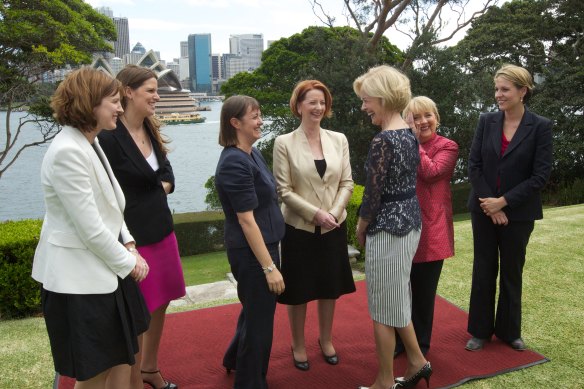
A different world: Governor-General Quentin Bryce speaks to female ministers in Julia Gillard’s government, including Kate Ellis (second from left), after their swearing-in at Admiralty House in 2011.Credit: Wolter Peeters
This kind of scrutiny still affects female MPs every day. And it can be truly distracting and destabilising when, no matter what you do or say, there is a focus every day not on how you think and perform but how you look.
Blair Williams is an Associate Lecturer in the School of Politics and International Relations at the Australian National University. As part of her PhD she studied the manner in which sexist and demeaning comments about female MPs and their physical appearance and outfits have actually become significantly worse since Margaret Thatcher allegedly smashed the glass ceiling as Britain’s first female prime minister in the late 1970s. Williams found there was much more gendered discussion of Theresa May in 2016 than there was of Thatcher in 1979. Williams also found the same was true of Julia Gillard when she became Australia’s first female prime minister in 2010.
Gillard told me that Williams’ research showed the extent to which women could be trivialised on the basis of their appearance even when they were involved in momentous policy work.
“Some of the stuff printed about Theresa May was unbelievable,” she said. “I mean, things like that photo of her next to the Scottish leader, Nicola Sturgeon, where they were both in skirts with their legs crossed. And it’s like: ‘Forget Brexit – who won Legs-it?’.”
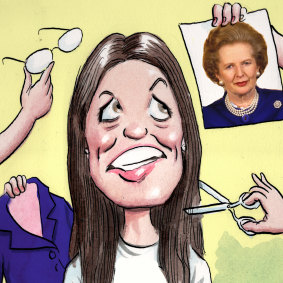
Kate Ellis was told to undertake a makeover similar to one Margaret Thatcher once had.Credit: Illustration: John Shakespeare
As a trailblazing youthful MP, former Australian Democrats Leader Natasha Stott Despoja found herself in the unwinnable position of being asked constantly about her outfits – principally her signature Doc Martens – and then being attacked for being trivial.
“There certainly wasn’t a week that went by in the Senate where someone in the parliament didn’t comment on how I looked,” Natasha said.
Amanda Rishworth told me about the online feedback she received about her “messy” hair. Karen Andrews spoke of being told that she looked like she was wearing “Michael Jackson’s jacket”. Sarah Hanson-Young cringed while remembering a magazine running a story about her cleavage being on display. “It was unbelievable,” she told me. “I was actually asking a question during question time. It was put to me that, how could I be serious about asking my question when I had my boobs hanging out?”
When I arrived in Canberra in 2004, I tried to ensure that people’s preoccupation with the physical appearance of female MPs wasn’t an issue I had to face. I had put some thought into what I would wear on the day I arrived. Like many twentysomethings who needed a new professional-looking outfit, I had gone to Cue to buy something sensible and unremarkable. I’d settled on a nondescript blue-grey pinstripe pantsuit. I teamed it with a simple black camisole and some standard black heels. I entered the chamber excited to be sworn in as a real-life politician.
I was surprised the following day to see that I had been mentioned in two different newspapers even though I had done nothing more than been sworn in along with every other member of the House of Representatives. The Age ran a piece which stated: “Kate Ellis – who seems a lot younger than her 27 years – looked like she was on a day out to the cricket.” The Daily Telegraph wrote that “new girl Kate Ellis donned impossibly tight pants”. Shit. This was actually my best effort at dressing the way I thought a politician was supposed to. What the hell was I meant to wear?
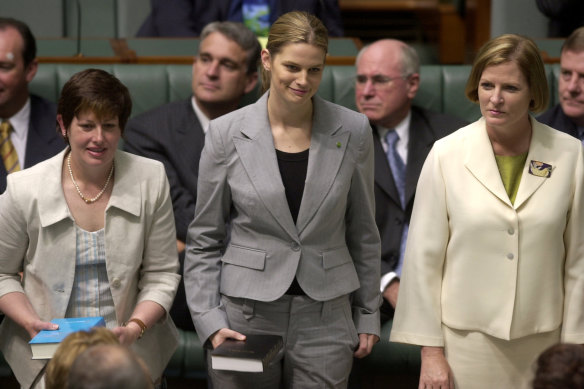
Kate Ellis on the day of her first swearing-in as an MP in 2004.Credit: Graham Tidy
As she so often does, Tanya Plibersek bluntly summarised what women need to aim for. “It’s sort of blandness that you’re going for. It’s not too pretty. Not too ugly. Somewhere in the middle. That’s the sweet spot for women.”
Julie Bishop decided to go the other way: “I have always loved fashion, ever since I was a little girl, and I had a professional career before going into parliament. I had worked in law firms for 20 years.
“So when I went into politics, it was natural for me to combine what I thought was a professional standard of dress with my love of fashion. Over time I did find that it was used as a supposed weapon against me, suggesting that if I were interested in fashion, I could not be interested in serious political issues.
“The more that it was raised, the more determined I was to not let others define who I was or how I dressed or what I could achieve.”
No matter how you choose to address the challenge, there are consequences of this fascination with women’s looks and appearance. For me, there is no question that I suffered from imposter syndrome in the first years of my political career. The American Psychological Association characterises imposter syndrome as occurring “among high achievers who are unable to internalise and accept their success. They often attribute their accomplishments to luck rather than to ability, and fear that others will eventually unmask them as a fraud.”
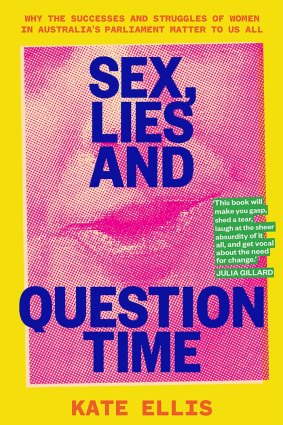
Sex, Lies and Question Time by Kate Ellis.Credit:
I didn’t have to fear being unmasked as a fraud. It happened daily. I didn’t look like a politician, I didn’t dress appropriately for a politician, I didn’t fit the mould of a politician.
And of course, there are also other consequences. Gillard noted that one of the biggest of these was less time in her diary.
“It’s measured in hours of lost time,” she said. “Before I was prime minister, all those years, I did the Today show debate with Tony Abbott on a Friday. So I’d come out of Canberra
after a spirit-crushing, mind-numbingly huge parliamentary week. You’d dash on a flight to Sydney, get up ridiculously early Friday morning to be across all of the newspapers and media. And I used to get to Channel Nine at 6.30 in the morning for make-up and hair. And we used to go to air about ten past seven. Tony would meander in at about three minutes past seven. I always bloody resented that half-hour.”
I have experienced many of these moments, but there are two that stand out.
I don’t just groan aloud about revisiting the Grazia magazine story about me. I actively avoid it. This whole book was almost completed before I could finally bring myself to revisit the whole absurd affair.
After the 2007 election I entered the Rudd government’s first ministry as the Minister for Youth and Sport. The 2007 Mission Australia Survey of Young Australians revealed that body image was the number one issue concerning our youth. So we created a Body Image Taskforce to develop concrete recommendations and produce a media code of conduct.
I wanted to speak directly to the young women most affected. Grazia was a leading fashion magazine at the time, and they contacted me to be part of a body image story and let their readers know how unrealistic the images that they portrayed were, how much Photoshopping and digital altering they did and why the ideal that they portrayed was in fact completely unattainable. I thought it was a brilliant idea.
We did a photo shoot where I got to wear the most amazing suit and shoes. We made it clear that we were leaving the pictures untouched. Still good. Until the very last bit. The stylist suggested we just take a couple more photos in a different outfit. She picked out a tight leather dress. She teamed it with a pair of studded black Gucci heels. At the time I thought, well, it’s not really my style, but it is their magazine. I’ll go with it if it means getting my message out there. You can probably guess which picture they ran.
The article was published in the very slow news cycle just before the Easter break. The photos were picked up by everyone. Mass outrage and controversy ensued. Did I get my message out to the target audience of Grazia readers? Maybe. I was naive and foolish to not realise that I would also be sending out a different message to the broader public, who had no idea of the context. That message was that I was a vacuous show pony, allegedly unfit to be a government minister.
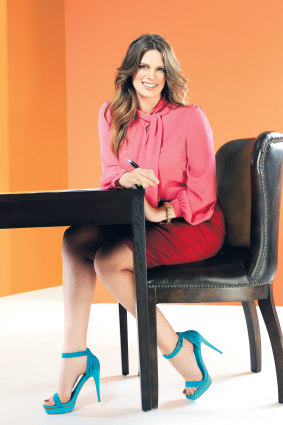
Kate Ellis photographed for Sunday Life magazine, 2011.Credit: Tom Holland
Yet the truth is that sometimes it doesn’t actually matter what you do, or how careful you are about what you wear; your message can still be overshadowed.
In June 2011 Fairfax’s Sunday Life magazine ran an interview with me about women in leadership roles. I was the Minister for the Status of Women at the time and proud to be working on the establishment of the Workplace Gender Equality Agency.
When I was approached by Sunday Life to speak on the issue of women in leadership roles as their cover story, I jumped at the suggestion. Having learnt from the Grazia ordeal, I also insisted that the photo shoot would only be done in appropriate office wear. A high-neck, long-sleeved pink pussy-bow blouse, a knee-length pencil skirt and some gorgeous aqua heels. Again, I thought, what could possibly go wrong?
A few weeks after the story, Sunday Life ran a follow-up. It featured the same photograph but this time under the headline “What’s wrong with this picture?“. The article explained that the criticism they received following the original publication was “relentless”. As the journalist wrote at the time: “More than a few of our readers (almost all of them women) viewed Ellis’ make-up, clothes and, in particular, her shoes as inappropriate.”
But it wouldn’t have mattered if I was in different shoes; one woman wrote to me complaining of the pink shirt as if I were trying to “look like Barbie”. Another thought my long hair made me look more like the secretary than a minister.
For what it is worth, the Workplace Gender Equality Agency was established in 2012 with mandatory reporting requirements for business. It has become an important organisation and its annual reports shine a spotlight on the progress being made for women at work. The organisation also offers vital support to encourage businesses to establish best practice and to receive public recognition when they do.
This is an edited extract from Sex, Lies and Question Time by Kate Ellis, published by Hardie Grant Books, RRP $39.99. Available in stores nationally.